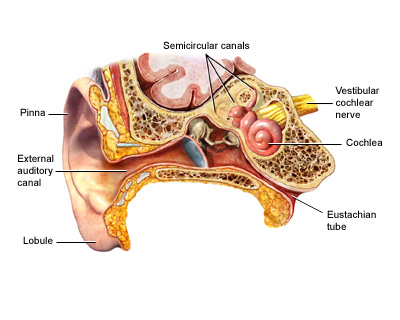Otosclerosis
Otosclerosis is an abnormal bone growth in the middle ear that causes hearing loss.

Causes
The cause of otosclerosis is unknown. However, there is some evidence that it may be passed down through families.
People who have otosclerosis have an abnormal sponge-like bone growing in the middle ear. This growth prevents the ear bones from vibrating in response to sound waves. Such vibrations are needed in order for you to hear.
Otosclerosis is the most common cause of middle ear hearing loss in young adults. It typically begins in early to mid-adulthood. It is more common in women than in men. The condition may affect one or both ears.
Risks for this condition include pregnancy and a family history of hearing loss. Caucasians are more likely to develop this condition than people of other races.
Symptoms
- Hearing loss (slow at first, but gets worse over time)
- Ringing in the ears (tinnitus)
- Vertigo or dizziness
Exams and Tests
A hearing test (audiometry /audiology) may help determine the severity of hearing loss.
A special imaging test of the head called a temporal-bone CT may be used to look for other causes of hearing loss.
Treatment
Otosclerosis may slowly get worse. The condition may not need to be treated until you have significant hearing problems.
Medications such as fluoride, calcium, or vitamin D may help to slow the hearing loss, but the benefits have not yet been proved.
A hearing aid may be used to treat the hearing loss. This will not cure or prevent hearing loss from getting worse, but it may help relieve some of the symptoms.
Surgery to remove part of the ear (stapes) and replace it with a prosthesis can cure conductive hearing loss. A total replacement is called a stapedectomy. Sometimes only part of the stapes is removed and a small hole is made in the bottom of it. This is called a stapedotomy. Sometimes a laser is used to help with the surgery.
Outlook (Prognosis)
Otosclerosis gets worse without treatment. Surgery may restore at least some of your hearing. Pain and dizziness from the surgery usually go away within a few weeks.
To reduce the risk of complications after surgery:
- Do not blow your nose for 2 -3 weeks after surgery.
- Avoid people with respiratory or other infections.
- Avoid bending, lifting, or straining, which may cause dizziness.
- Avoid loud noises or sudden pressure changes, such as scuba diving, flying, or driving in the mountains until you have healed.
If surgery does not work, you may have total hearing loss. Treatment then involves developing skills to cope with deafness, and using hearing aids to transmit sounds from the non-hearing ear to the good ear.
Possible Complications
- Complete deafness
- Funny taste in the mouth
- Infection, dizziness, pain, or a blood clot in the ear after surgery
- Nerve damage
When to Contact a Medical Professional
Call your health care provider if:
- You have hearing loss
- You develop fever, ear pain, dizziness, or other symptoms after surgery
Alternative Names
Otospongiosis; Stapedectomy

